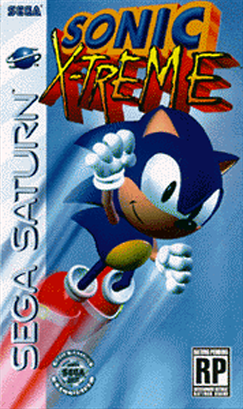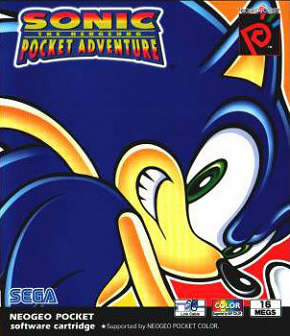
Sonic Adventure is a 1998 platform game developed by Sonic Team and published by Sega for the Dreamcast. It was the first main Sonic the Hedgehog game to feature 3D gameplay. It follows Sonic the Hedgehog, Miles "Tails" Prower, Knuckles the Echidna, Amy Rose, Big the Cat, and E-102 Gamma in their quests to collect the Chaos Emeralds and stop Doctor Robotnik from unleashing Chaos, an ancient evil. Controlling one of the six characters—each with their own abilities—players complete levels to progress the story. Sonic Adventure retains many elements from prior Sonic games, such as power-ups and the ring-based health system. Players can play minigames such as racing and interact with Chao, a virtual pet.

Sonic Heroes is a 2003 platform game developed by Sonic Team USA and published by Sega as part of the Sonic the Hedgehog series. The player races a team of series characters through levels to amass rings, defeat robots, and collect the seven Chaos Emeralds needed to defeat Doctor Eggman. Within each level, the player switches between the team's three characters, who each have unique abilities, to overcome obstacles. Sonic Heroes downplays the action-adventure and exploration-based gameplay of its predecessors Sonic Adventure (1998) and Sonic Adventure 2 (2001) in favor of returning to the linear style of Sega Genesis-era Sonic games.

Sonic the Hedgehog is a 1991 platform game developed by Sonic Team and published by Sega for the Genesis/Mega Drive. It was released in North America on June 23 and in PAL regions and Japan the following month. Players control Sonic the Hedgehog, who can run at near supersonic speeds; Sonic sets out on a quest to defeat Dr. Robotnik, a scientist who has imprisoned animals in robots and seeks the powerful Chaos Emeralds. The gameplay involves collecting rings as a form of health, and a simple control scheme, with jumping and attacking controlled by a single button.

Sonic the Hedgehog is a 1991 platform game. It is a companion to the 16-bit Sega Genesis game Sonic the Hedgehog for the 8-bit Sega Master System and Game Gear consoles. Ancient—a studio founded by composer Yuzo Koshiro for the project—developed the game and Sega published it to promote the handheld Game Gear. The 8-bit Sonic is a side-scrolling game similar in style to the 16-bit game, but reduced in complexity to fit the 8-bit systems.

Ristar is a 1995 platform game developed and published by Sega for the Sega Genesis. The game stars an anthropomorphic cartoon star who uses his hands and long, stretchable arms to both move and fight enemies. Reception for the game was generally positive, but the game's initial release was overshadowed due to the imminent ending of the Genesis's lifecycle and the succession of the Sega Saturn and other fifth generation video game consoles.

Sonic 3D Blast, known in Europe and Japan as Sonic 3D: Flickies' Island, is a 1996 platform game in the Sonic the Hedgehog series for the Sega Genesis and Sega Saturn. As Sonic the Hedgehog, the player embarks on a journey to save the Flickies, birds enslaved by Doctor Robotnik. The player must guide Sonic through a series of themed levels to collect Flickies and defeat Robotnik. Though it retains game mechanics from prior Sonic games, Sonic 3D Blast is differentiated by its 2D isometric perspective, with pre-rendered 3D models converted into sprites.

Knuckles' Chaotix is a 1995 platform game developed by Sega for the 32X. A spin-off from the Sonic the Hedgehog series, it features Knuckles the Echidna and four other characters known as the Chaotix, who must prevent Doctor Robotnik and Metal Sonic from obtaining six magic rings and conquering a mysterious island. Gameplay is similar to previous Sonic games: players complete levels while collecting rings and defeating enemies. Knuckles' Chaotix introduces a partner system whereby the player is connected to another character via a tether; the tether behaves like a rubber band and must be used to maneuver the characters.

Sonic Advance is a 2001 platform video game developed by Sonic Team and Dimps and published by Sega for the Game Boy Advance. It was the first Sonic the Hedgehog game to be released on a Nintendo console with Sonic Adventure 2: Battle on the GameCube, and was produced in commemoration of the series' tenth anniversary. The story follows Sonic, Tails, Knuckles, and Amy as they journey to stop Doctor Eggman from taking over the world. Controlling a character, players are tasked with completing each level, defeating Eggman and his robot army, and collecting the seven Chaos Emeralds.

Sonic the Hedgehog Spinball, also known as Sonic Spinball, is a 1993 pinball video game developed by Sega Technical Institute and published by Sega. It is a spinoff of the Sonic the Hedgehog series. Players control Sonic the Hedgehog, who must stop Doctor Robotnik from enslaving the population in a giant pinball-like mechanism. The game is set in a series of pinball machine-like environments with Sonic acting as the pinball.

Sonic X-treme was a platform game developed by Sega Technical Institute from 1994 until its cancellation in 1996. It was planned as the first fully 3D Sonic the Hedgehog game, taking Sonic into the 3D era of video games, and the first original Sonic game for the Sega Saturn. The storyline followed Sonic on his journey to stop Dr. Robotnik from stealing six magic rings from Tiara Boobowski and her father. X-treme featured open levels rotating around a fixed center of gravity and, like previous Sonic games, featured collectible rings and fast-paced gameplay.

Sonic Labyrinth is an action-puzzle game developed by Minato Giken and published by Sega for the Game Gear in 1995. The game features Sonic the Hedgehog exploring maze-like stages from an isometric perspective. Dr. Robotnik has robbed Sonic of his trademark speed, so Sonic walks slowly but can roll into a ball and dash across the stages.

Sonic the Hedgehog Pocket Adventure is a platform game developed and published by SNK for the Neo Geo Pocket Color in 1999. The game is based on Sonic the Hedgehog 2 (1992) for the Sega Genesis, borrowing much of the stage themes and gameplay elements, but featuring unique stage layouts, elements from other Genesis Sonic the Hedgehog games, and extra game modes. Sega's Yuji Naka and the rest of Sonic Team supervised over production.

Sonic the Hedgehog: Triple Trouble is a 1994 platform game developed by Aspect and published by Sega for the Game Gear. It is the sequel to Sonic Chaos (1993) and features classic side-scrolling Sonic gameplay. The player controls either Sonic the Hedgehog or Miles "Tails" Prower as they venture to protect the powerful Chaos Emeralds from Doctor Robotnik, Knuckles the Echidna, and series newcomer Nack the Weasel. Sonic and Tails' unique abilities, as well as various power-ups, can assist the player in gameplay.

Sonic the Hedgehog 2 is a 1992 platform game developed by Aspect and published by Sega for the Master System and Game Gear. It is the sequel to the 8-bit Sonic the Hedgehog (1991) and follows Sonic as he attempts to get the Chaos Emeralds back to rescue his friend Miles "Tails" Prower from Dr. Robotnik. Like the first Sonic the Hedgehog, players run through levels at high speeds while collecting rings and defeating enemies. Although it shares the same title with Sonic the Hedgehog 2 for the Sega Genesis and their releases coincided, the games have little in common and share no levels.

Sonic the Hedgehog 2 is a 1992 platform game developed by Sega Technical Institute (STI) for the Sega Genesis. Players control Sonic as he attempts to stop Doctor Robotnik from stealing the Chaos Emeralds to power his space station. Like the first Sonic the Hedgehog (1991), players traverse side-scrolling levels at high speeds while collecting rings, defeating enemies, and fighting bosses. Sonic 2 introduces Sonic's sidekick Miles "Tails" Prower and features faster gameplay, larger levels, a multiplayer mode, and special stages featuring pre-rendered 3D graphics.

Sonic Rush Adventure is a 2007 platform game developed by Dimps and Sonic Team and published by Sega for the Nintendo DS. The sequel to 2005's Sonic Rush, it follows Sonic the Hedgehog and Tails, who are teleported to an alternate dimension and seek the help of Blaze the Cat, while battling a band of robot pirates. Gameplay is similar to prior installments in the Sonic the Hedgehog franchise, with players controlling Sonic or Blaze through a series of side-scrolling levels while collecting rings and defeating enemies. Sonic Rush Adventure deviates from prior games with its elements of sea travel, featuring boating minigames that take advantage of the DS's touchscreen.

Sonic Unleashed is a 2008 platform game developed by Sonic Team and published by Sega as part of the Sonic the Hedgehog series. The plot follows Sonic as he attempts to restore the world after his nemesis Doctor Eggman shatters it with a powerful laser to unleash Dark Gaia, an ancient evil which periodically transforms Sonic into a werewolf form. Gameplay features two distinct styles: daytime stages incorporate Sonic's traditional platforming and trademark speed; while night-time stages see Sonic transform into the Werehog and engage in slower combat against waves of enemies using the Werehog's brute strength.

Sonic the Hedgehog 4: Episode I is a 2010 platform game developed by Dimps, with assistance from Sonic Team, and published by Sega. It is a sequel to Sonic & Knuckles (1994), following Sonic as he sets out to stop a returning Doctor Eggman. Like the Sonic the Hedgehog games released for the Sega Genesis, Episode I features side-scrolling gameplay, with movement restricted to a 2D plane. The player races through levels collecting rings while rolling into a ball to attack enemies. The game also features special stages in which the player collects Chaos Emeralds and online leaderboards comparing level completion times and high scores.

Sonic After the Sequel is a 2013 platform video game created by Brazilian student Felipe Daneluz (LakeFeperd). It is an unofficial game based on the Sonic the Hedgehog series and set between the official games Sonic the Hedgehog 2 and Sonic the Hedgehog 3. Daneluz's second Sonic game, it follows Sonic Before the Sequel, which is set between the original Sonic the Hedgehog and Sonic the Hedgehog 2. Like its predecessor, After the Sequel stars Sonic the Hedgehog and his sidekick Tails in a quest to retrieve the Chaos Emeralds from Doctor Eggman.

Sonic Forces is a 2017 platform game developed by Sonic Team and published by Sega. It was produced in commemoration of the 25th anniversary of the Sonic the Hedgehog franchise. The plot focuses on Sonic the Hedgehog joining a resistance movement formed by his friends, alongside its rookie and his misplaced past self. Together, they must stop Doctor Eggman, who has conquered most of the world alongside Infinite, his newest lackey who has been empowered by the Phantom Ruby. It features three gameplay modes: "Classic", side-scrolling gameplay similar to the original Sega Genesis Sonic games, "Modern", 3D gameplay similar to Sonic Unleashed (2008) and Sonic Colors (2010), and a mode featuring the "Avatar", the player's custom character.



















